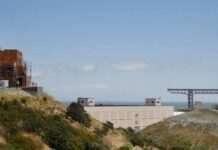by Lee Houskeeper

Daniel Hirsch, president of the nonprofit Committee to Bridge the Gap and former director of the Program on Environmental and Nuclear Policy at the University of California Santa Cruz, spoke with the press in advance of a community presentation at Hunters Point Shipyard. Many Shipyard residents have been frustrated with what they feel are less than forthcoming answers from the Navy and regulatory agencies regarding the radioactive contamination at the Shipyard. Hirsch presented independent research and information on Hunters Point, including two new reports he and his colleagues at Committee to Bridge the Gap are releasing.
First report: Radioactive work at Hunters Point
Key conclusions: The extent of radioactive activities at Hunters Point was far greater than the public has been led to believe. A wide array of radionuclides, numbering in the dozens, was involved, often in extremely large quantities.
No portion of Hunters Point can be deemed non-impacted, since the radioactivity was susceptible to widespread migration throughout the site. Effective cleanup will be a massive undertaking, requiring a level of diligence far greater than that which has been demonstrated by the Navy to date, whose poor environmental and safety practices led to the widespread contamination in the first place.

Second report: The majority of Hunters Point sites were never sampled for radioactive contamination
The public would reasonably think that sampling of soil and other materials for radioactive contamination had been performed across the whole Hunters Point Shipyard (HPS) site, and with numbers of samples and techniques sufficient to have high confidence that potential contamination was not overlooked.
In fact, the Navy decided to exempt approximately 90 percent of the locations (792 of 883 HPS sites) at Hunters Point from any soil sampling or building measurements.
No sampling conducted for the great majority of radionuclides
In addition to not sampling the great majority of HPS at all, what sampling was done did not include measurements for the great majority of radionuclides of concern. No cleanup levels were established for them, thus allowing unlimited levels of contamination if present.

Furthermore, most soil measurements did not even include the most critical radionuclides like strontium-90 and plutonium-239.
In the 2004 Historical Radiological Assessment (HRA) the Navy identified 108 radionuclides used at HPS. The HRA then reduced the list of 108 radionuclides used at HPS to 33 radionuclides of concern.
Despite over a hundred radionuclides identified as having been used at HPS and 33 deemed in the HRA to be “radionuclides of concern,” during actual sampling and cleanup, however, only a few radionuclides were considered. For example, the Navy now claims that there are only three or four radionuclides of concern in Parcel G and sets cleanup standards only for those.
Background measurements taken from potentially contaminated areas

To know if measurements taken at Hunters Point represent contamination, it must first be known how much radioactivity there is in local “background” – the level of naturally occurring radionuclides and global fallout, i.e., how much radioactivity there would be if the Navy had never been there. The Multi-Agency Radiological Survey and Site Investigation Manual (MARSSIM), which contractors employed by the Navy are supposed to follow, defines a non-impacted area as “an area where there is no reasonable possibility (extremely low probability) of residual contamination.”
These areas determined to be non-impacted, if truly free from any contamination, can reasonably be used for background reference areas. What has been and continues to be done at HPS, however, is to use locations in the midst of the contaminated Superfund site for background, areas that have a significant likelihood of being radiologically contaminated themselves, but were inappropriately labeled as “non-impacted.”

Having not sampled the great majority of Hunters Point sites and for the great majority of the radionuclides of concern, and inflating background values, Tetra Tech nonetheless appears to have fabricated or falsified readings from 90-97 percent of the HPS survey units that were measured according to the EPA.
In summary, the great majority of Hunters Point soil was never sampled and what samples were taken ignored the great majority of the radionuclides of concern, with unlimited contamination levels allowed without requiring cleanup. Only a tiny fraction of HPS and the radionuclides of concern were subject to sampling, and only a tiny fraction of those samples are free of evidence of fabrication.
Essentially, none of the entire HPS radiological cleanup endeavor to date can be relied upon to assure protection of the public.
Contact Lee Houskeeper of San Francisco Stories at Newsservice@aol.com.
Read the entire reports and a presentation that amply demonstrates the history and the present state of radioactivity at the Hunters Point Shipyard:
- Report 1: Hunters Point Naval Shipyard: The Nuclear Arms Race Comes Home– Oct. 18, 2018
- Report 2: The Great Majority of Hunters Point Sites Were Never Sampled for Radioactive Contamination — And the Testing That Was Performed Was Deeply Flawed– Oct. 18, 2018
- Hunters Point Community Presentation 10-18-18 This presentation – extremely clear, well illustrated and easy to understand – should be seen by everyone with an interest in or contact with the Hunters Point Naval Shipyard.

 Store
Store




